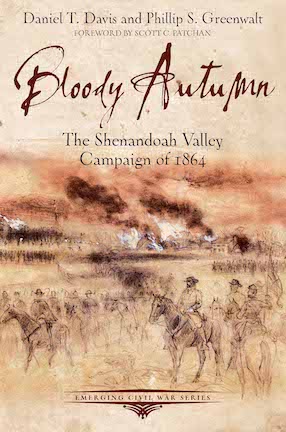“In pushing up the Shenandoah Valley . . . it is desirable that nothing should be left to invite the enemy to return. Take all provisions, forage, and stock wanted for the use of your command; such as cannot be consumed, destroy.”
— Lt. Gen. Ulysses S. Grant to Maj. Gen. Philip Sheridan
Bloody Autumn: The Shenandoah Valley Campaign of 1864
by Daniel T. Davis and Phillip Greenwalt
Savas Beatie, 2013
168 pp.; 194 images, 10 maps
ISBN: 978-1-61121-165-8
Click here to order
“[A] good overview of battles and campaigns and . . . an essential addition to serious students’ libraries.” — Civil War News
“The authors’ style is both easy to read and informative resulting in an enjoyable book well worth having.” — TOCWOC
* * *
Clear out the Shenandoah Valley “clean and clear,” Union General-in-Chief Ulysses S. Grant ordered in the late summer of 1864.
His man for the job: Major General “Little Phil” Sheridan, the bandy-legged Irishman who’d proven himself just the kind of scrapper Grant loved. Grant turned Sheridan loose across Virginia’s most vital landscape, the breadbasket of the Confederacy.
In the spring of 1862, a string of Confederate victories in the Valley had foiled Union plans in the state and kept Confederate armies fed and supplied. In 1863, the Army of Northern Virginia used the Valley as its avenue of invasion, culminating in the battle of Gettysburg. The Valley continued to offer Confederates an alluring backdoor to Washington D.C.
But when Sheridan returned to the Valley in 1864, the stakes jumped dramatically. To lose the Valley would mean to lose the state, Stonewall Jackson had once said—and now that prediction would be put to the test as Sheridan fought with Confederate Lieutenant General Jubal Early for possession.
For the North, the fragile momentum its war effort had gained by capturing Atlanta would quickly evaporate; for Abraham Lincoln, defeat in the Valley could very well mean defeat in the upcoming election. For the South, more than its breadbasket was at stake—its nascent nationhood lay on the line.
Historians Daniel Davis and Philip Greenwalt, longtime students of the Civil War, have spent countless hours researching the Valley battles of ‘64 and walking the ground where those battles unfolded. Bloody Autumn: The Shenandoah Valley Campaign of 1864 shifts attention away from Army of the Potomac and the Army of Northern Virginia to the campaign that ultimately determined the balance of power across the Eastern Theater.
* * *
Bloody Autumn also includes:
- A foreword by Scott Patchan
- Driving Tours of Third Winchester, Fisher’s Hill and Tom’s Brook, and Cedar Creek
- Appendix A: Winchester During the War
- Appendix B: John Mosby, George Custer, and the Front Royal Executions by Daniel T. Davis
- Appendix C: The Valley Campaign for Memory by Chris Mackowski & Phillip Greenwalt
- Appendix D: Preserving the Shenandoah Valley’s Civil War Battlefields by Eric Campbell
- Order of Battle for the Shenandoah Valley Campaign of 1864
* * *
About the Authors: Daniel Davis has worked as a historian at Appomattox Court House National Historic Site and the Fredericksburg and Spotsylvania National Military Park. He is the co-author of several books in the Emerging Civil War Series, including (with Phillip S. Greenwalt) Bloody Autumn: The Shenandoah Valley Campaign of 1864, Hurricane from the Heavens: The Battle of Cold Harbor, and Calamity in Carolina: The Battles Averasboro and Bentonville and (with Chris Mackowski and Kristopher D. White) Fight Like the Devil: The First Day at Gettysburg July 1, 1863. He resides in Fredericksburg, Virginia.
Phillip Greenwalt graduated from George Mason University with a MA in American History and also has a BA in history from Wheeling Jesuit University. He is currently a Supervisory Park Ranger in Interpretation and Visitor Services for Everglades National Park. Prior to his currently position, Phillip spent seven years a historian with the National Park Service at George Washington Birthplace National Monument and Thomas Stone National Historic Site. He started with the National Park Service as a historical interpreter intern at Fredericksburg and Spotsylvania National Military Park. He currently resides in South Florida.

6 Responses to Bloody Autumn